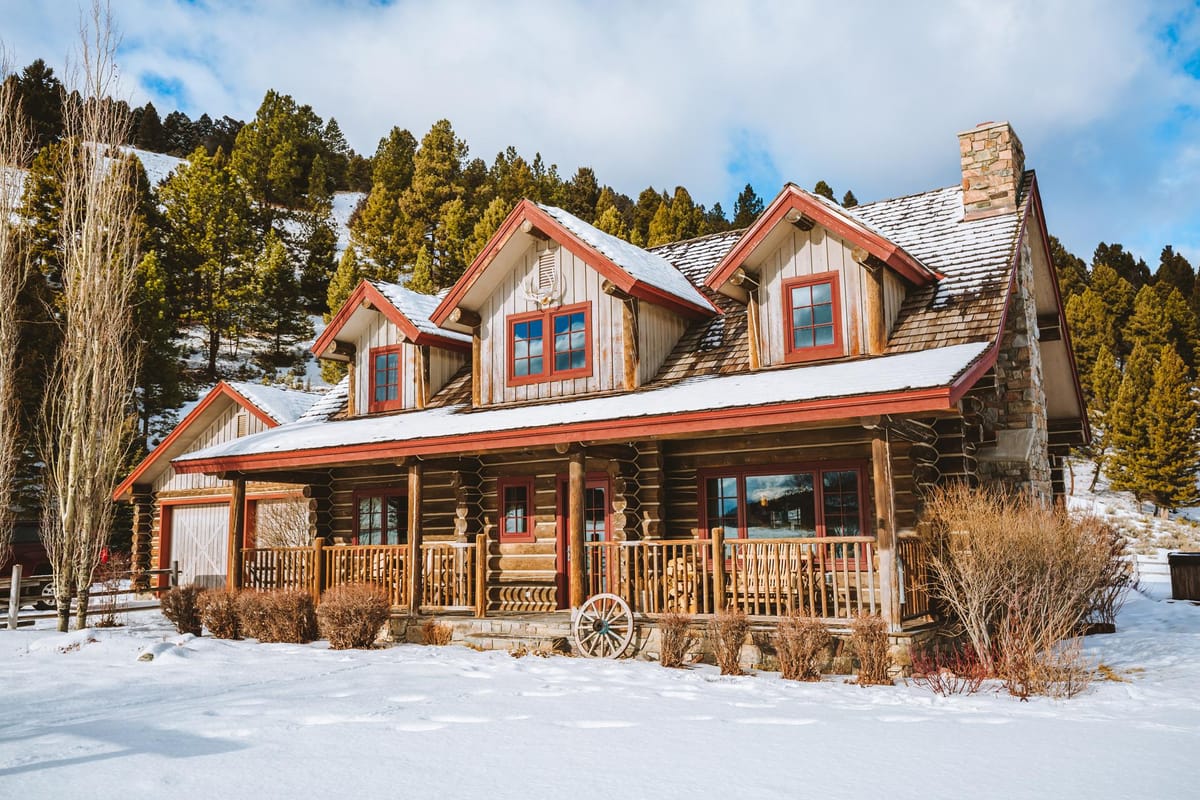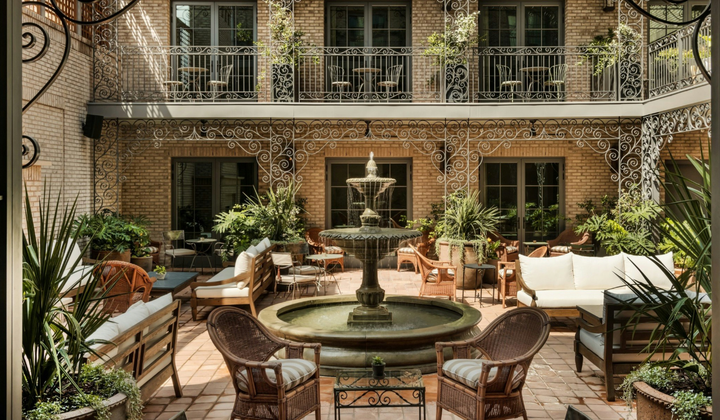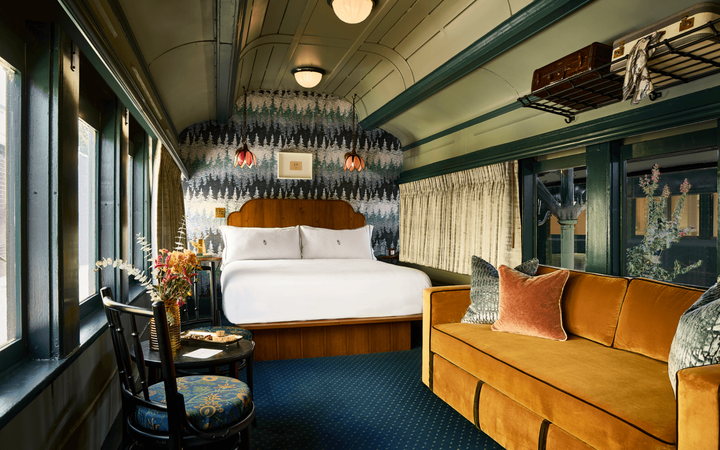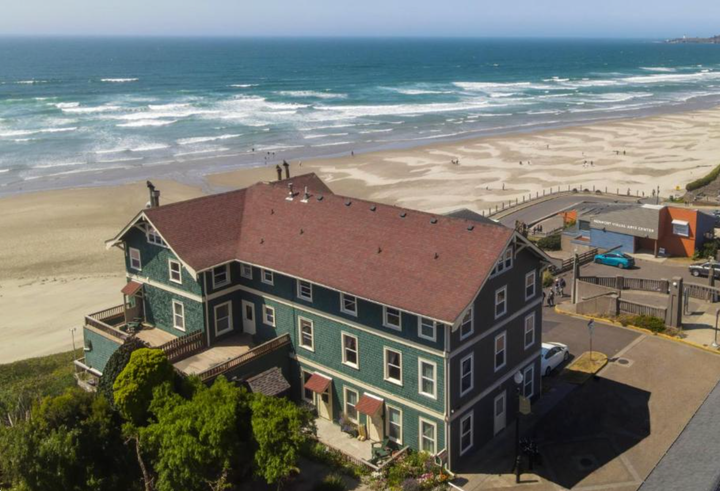Designing with nature
Plus: Adventure meets luxury at an all-inclusive Montana getaway

Phenomenal hotels don’t just host—they wow. This week, we’re exploring how landscape design shapes vibrant, inviting spaces (because a great patio is just as important as a great pillow). With AI evolving, will your next hotel stay be booked by a bot? And once guests arrive, a stunning, illustrated property map can turn navigation into an adventure rather than a guessing game. Let’s traverse how thoughtful design—whether in greenery, tech or wayfinding—can elevate the guest experience.
Plus, read about how a luxury ranch in Montana perfects the art of the all-inclusive getaway.

Translating revenue into profit. RevPAR is a critical metric, but factoring in TRevPAR (Total Revenue Per Available Room) and GOPPAR (Gross Operating Profit Per Available Room) will give you a clearer picture of your bottom line.
Stopping trafficking in its tracks. HotelShield is piloting a new solution in the battle to end sex trafficking in U.S. hotels. Working directly with hospitality brands, operators and owners to prevent, detect and respond to human trafficking, this groundbreaking technology is reducing risk and enhancing safety for all.
A map tells a story. Rather than photo galleries or static landing pages, consider helping your guests navigate your property via an illustrated map. Mapping your property shows guests where they will eat, sleep and explore—all in one artful glance.
Giddy up, convention goers. Business and pleasure will collide in Austin, Texas’ new $1.6B convention center, slated to open in early 2029. Beyond the 620,000 sq. feet of rentable indoor/outdoor space, "Unconventional ATX" will showcase a $17.7 million investment in public art.
Glamping meets astrology. Look past the Rockies and shoot straight for the stars at the soon-to-open Kosmos Stargazing Resort and Spa in Mosca, Colorado. When complete, the 20 futuristic domed stargazing villas will offer 360-degree views, interspersed around a central structure with a restaurant, spa and planetarium.


'It’s about creating moments of decompression'
Kona Gray, principal at Fort Lauderdale-based planning and landscape architecture firm EDSA, has a passion for creating spaces that inspire and connect communities. With decades of experience in landscape architecture in more than 30 countries, he blends creativity with strategic thinking to shape environments that are both beautiful and functional. His work spans the globe, from urban developments to resort destinations, always with a focus on sustainability and cultural authenticity. Here, he shares how a property’s history and character informs its physical identity and why designing with nature is essential for connection and even profitability. -Jennifer Glatt
How do you approach landscape design to reflect the unique identity and culture of a boutique or independent hotel?
Designing landscapes for boutique hotels is about crafting environments that reflect the property's unique identity. Design begins with a deep understanding of each location’s history and character, which provides a foundation for designs that are not only beautiful but meaningful and rooted in place. Every site has its own unique character, and it’s this uniqueness that tells the story and helps a place endure the test of time. For example, at Naviva, a Four Seasons Resort, EDSA’s design team immersed themselves in the Huichol culture. From motifs throughout the site that pay homage to the region’s traditional monarch butterfly to the use of local materials such as permeable concrete and bamboo, every space and amenity is thoughtfully designed to offer guests an unforgettable experience.
What elements are critical to creating intentional moments throughout hotels?
First and foremost, the design must be intentional—everything should reflect the hotel’s unique personality and its surroundings, rooted in both place-making and place-keeping. Guests are looking for experiences that evoke emotions they can’t find anywhere else, so we always aim to discover those distinct elements that make a space truly special and connected to its location. Place-making involves crafting spaces that forge a deep connection between guests and the environment, while place-keeping ensures those spaces stay true to their original essence over time. In addition, sensory experiences—sight, sound, smell and touch—are critical in forging emotional connections.
How does landscape design help create welcoming public places that bring a strong sense of vitality to a property?
The key to creating inviting public spaces in boutique and independent hotels is designing areas that foster a sense of transformation. These hotels offer a unique opportunity to take guests on a journey, allowing them to move from one space to another, much like a metamorphosis. Thoughtfully incorporating elements encourages reprieve from the ordinary within outdoor spaces where guests can unwind and engage with the environment. And, whether at a destination resort or an urban hotel, it’s about creating moments of decompression—a chance to breathe before stepping into the hotel. Even simple features, like a courtyard with water or the scent of flowers, can provide that sense of calm. Blurring the lines between indoor and outdoor spaces creates a lasting connection to nature, offering guests a fresh way to experience their surroundings.
What trends are shaping the future of landscape architecture in hospitality?
The return to nature is becoming a defining element in design, with a growing emphasis on integrating natural elements and sustainability into hospitality properties. While this trend is nothing new to landscape architects, it’s exciting to see hotel developers and operators prioritizing green spaces, biophilic design and environmental responsibility as key factors in their projects. Flexible open spaces, outdoor wellness areas and additional environmentally driven amenities are becoming not just a want, but a need for hoteliers who want to be successful in the long term. This trend is shifting the focus from purely aesthetic appeal to creating environments that foster a deeper connection between people and the natural world.
This interview has been edited for brevity.
Above: Naviva, a Four Seasons Resort in Punta Mita, Mexico. (Courtesy of EDSA)


Destination of the Week: The Ranch at Rock Creek
Location: Near Philipsburg, Montana—a 90-minute drive from Missoula.
Owned by: Investment banker Jim Manley, who fulfilled a boyhood Western fantasy with the purchase of the land in 2007.
Opened in: A working ranch homestead since the early 1900s (the original 19th-century barn and other historical structures are still standing), the Ranch at Rock Creek opened its doors as a luxury getaway in 2010.
Rooms: 31 accommodations, ranging from glamping cabins to five-bedroom log cabins and suites in the main Granite Lodge.
What to expect: Live out your wildest Yellowstone dreams on 6,600 acres of pristine Montana wilderness, reimagined as the ultimate luxury playground.
The world’s first Forbes Travel Guide five-star guest ranch, this Relais & Châteaux property combines plush accommodations with over-the-top hospitality, world-class dining and a dream-come-true wish list of professionally guided adventures and excursions, from horse riding to snowmobiling, cross-country skiing, ice fishing, float trips, archery, rifle and pistol shooting, sapphire mining and more—complete with provided equipment and gear.
And put your wallet away while onsite; except for spa treatments, everything is included in your stay, from activities to airport transfers, meals and that well-deserved après ski glass of wine (or two) by the fireplace.
Dining options: Following a frontier-to-table philosophy, meals at the Ranch (served across four different dining venues, depending on the season) lean into local and seasonal ingredients. Each evening features a different dining experience, paired with standout wines and cocktails. (Pro-tip: freshly baked cookies served by the Lodge fireplace are also a must.)
What stands out: True to its Western roots, the property has its own private Silver Dollar Saloon—bowling alley, bar and karaoke stage included. And because no ranch is complete without horses, Rock Creek has a deeply cared-for 80-head herd of its own, equipped to handle all levels of riding abilities. Don’t miss the turnout of the herd near sunset, and if you’re lucky, you'll catch a glimpse of wildlife such as elk and eagles on the property, too.
Secret to success: “When I bought the Ranch 18 years ago, I just knew adults wanted to get out and play and do the things they did as a kid. And that was my thought—there's nothing that's authentic like a dude ranch, but has luxury and five-star food,” explains Manley, whose favorite time of year at the property is winter.
Starting at: $2,300 double occupancy, per day, all-inclusive. -Lesley McKenzie
Above: The Moose cabin at The Ranch at Rock Creek. (Courtesy)


Ben Wolff co-founded Onera—the landscape hotel brand that achieved the first public REIT exit of its kind. He now runs Oasi, a hotel marketing and management firm, and shares his playbook to attract the modern traveler in his weekly newsletter.
His social media strategies have generated 90M+ views and 80%+ direct bookings, effectively slashing OTA dependency for both his properties and clients like Alila Marea and Spoon Mountain.
In an era where Instagram drives more bookings than Expedia, Ben reveals:
- How to leverage social media to drive direct bookings and reduce OTA fees
- The design principles behind "one-of-one" experiential resorts that sell themselves
- Revenue maximization frameworks most hoteliers completely miss
No theory or fluff—just the actionable frameworks that have proven successful in the real world, whether you're optimizing an existing property or scaling a hospitality portfolio. Join Ben’s weekly newsletter here.
[Check out one of his latest issues: The Top Travel & Hospitality Trends in 2025]
Above: Onera Wimberly (Courtesy)

High-style hotels
Owner-managed properties can deliver hospitality in the most distinctive ways. With a growing presence in the U.S. and Mexico, Design Hotels is growing its mix of 300+ privately owned boutique properties, expanding its portfolio by 10 percent in the last year with the addition of 29 properties.
Why it matters: Think of owner-managed properties like a river cruise and large chain hotels like a traditional cruise line. You may visit the same destination, but the experience will be wholly different. Within the Design Hotels portfolio is the Hotel Borsari in Martigny, Switzerland, which offers 51 rooms in an area surrounded by gorges, thermal springs and mountain hiking trails. The Warren Street Hotel, a Firmdale Hotel in New York’s Tribeca district, is a 69-room Michelin Key bolthole offering private terrace gardens and skyscraper views of lower Manhattan and the Hudson River. (Top Hotel Projects)

Finding strategic value in going green
Sustainability standardization may not yet be settled, but eco-conscious travel is quickly becoming an essential guest expectation. How can hoteliers determine which green certifications and credentials are right for them? Turns out, there’s no universal solution, but hoteliers can identify strategies that offer the most value for their business.
Why it matters: Regulatory obligations and guest preferences are only part of the equation. Energy consumption, waste management, water conservation, guest education and market demand are contributing factors, as is the age of the property and local environmental laws. Benchmarking and implementing accurate data management is critical, not to mention measuring whether certifications lead to tangible returns—particularly in-room revenue. (Hotel Dive)

Smooth operator
The promise of frictionless travel planning could be closer than you think. "Operator, OpenAI’s new AI 'computer use' agent, is the next iteration of search," posits Michael J. Goldrich, chief experience officer at The Hotels Network and founder and chief advisor at Vivander Advisors. "Left unchecked, it may accelerate a shift that hoteliers aren’t ready for: a future where AI books rooms without guests ever visiting a hotel website."
Why it matters: If AI agents and Operator will dictate the booking journey, your hotel’s digital strategy needs to be on point, from brand recognition to owning first-party data, AI optimization to conversion. “The next chapter of hotel distribution won’t be won with better SEO or more paid ads,” Goldrich says. “It will be won by the hotels that understand the shift from human-driven search to AI-driven answers.” (The Hotels Network)

Breaking barriers… and beyond
Behind some of the world’s best hotels are prominent female leaders in hospitality. For one woman, two decades in the diamond industry informs her approach to detailed design. For another, shrugging off limiting gender roles led to an evolution from project liaison officer to roles encompassing brand development, cultural programming and partnerships, and charity and philanthropic endeavors. In continued recognition of Women’s History Month, Wallpaper recognizes five influential women hoteliers share their perspective on the changing face of hospitality.
Why it matters: Women are redefining hospitality convention, no permission requested. “It’s not about one gender replacing another, it’s about a broader vision where creativity, craftsmanship and leadership aren’t defined by who you are but by what you bring to the table,” says Thelma West, co-founder of the Casina Cinquepozzi hotel in Putignano, Puglia. “That’s what true progress looks like: an industry where the best ideas win, regardless of who they come from.” (Wallpaper)
💯 Enjoying Mint Pillow? Share it with a friend.
👋 Have a story idea or want to say hello? Email us at newsletter@mintpillow.co




